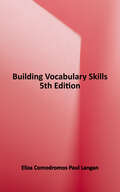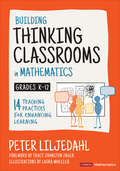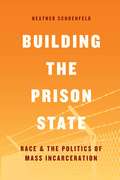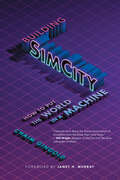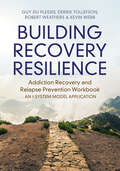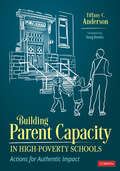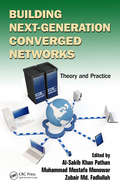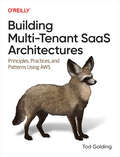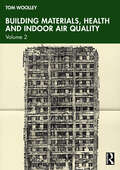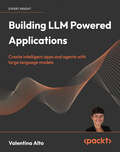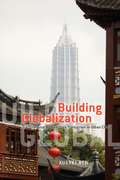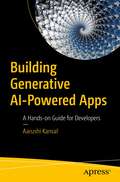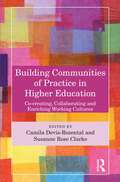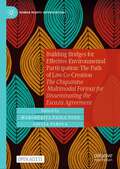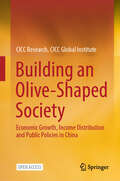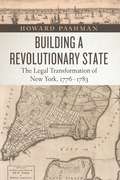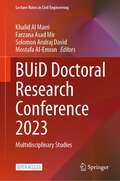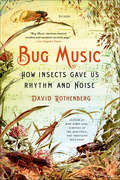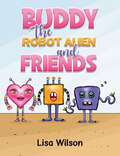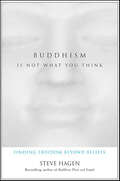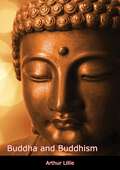- Table View
- List View
Building Vocabulary Skills, Fifth Edition
by Eliza Comodromos Paul LanganThis book introduces 300 essential words and word parts that are needed for general reading comprehension in high school and college.
Building Thinking Classrooms in Mathematics, Grades K-12: 14 Teaching Practices for Enhancing Learning (Corwin Mathematics Series)
by Peter LiljedahlA thinking student is an engaged student Teachers often find it difficult to implement lessons that help students go beyond rote memorization and repetitive calculations. In fact, institutional norms and habits that permeate all classrooms can actually be enabling "non-thinking" student behavior. Sparked by observing teachers struggle to implement rich mathematics tasks to engage students in deep thinking, Peter Liljedahl has translated his 15 years of research into this practical guide on how to move toward a thinking classroom. Building Thinking Classrooms in Mathematics, Grades K–12 helps teachers implement 14 optimal practices for thinking that create an ideal setting for deep mathematics learning to occur. This guide Provides the what, why, and how of each practice and answers teachers’ most frequently asked questions Includes firsthand accounts of how these practices foster thinking through teacher and student interviews and student work samples Offers a plethora of macro moves, micro moves, and rich tasks to get started Organizes the 14 practices into four toolkits that can be implemented in order and built on throughout the year When combined, these unique research-based practices create the optimal conditions for learner-centered, student-owned deep mathematical thinking and learning, and have the power to transform mathematics classrooms like never before.
Building Thinking Classrooms in Mathematics, Grades K-12: 14 Teaching Practices for Enhancing Learning (Corwin Mathematics Series)
by Peter LiljedahlA thinking student is an engaged student Teachers often find it difficult to implement lessons that help students go beyond rote memorization and repetitive calculations. In fact, institutional norms and habits that permeate all classrooms can actually be enabling "non-thinking" student behavior. Sparked by observing teachers struggle to implement rich mathematics tasks to engage students in deep thinking, Peter Liljedahl has translated his 15 years of research into this practical guide on how to move toward a thinking classroom. Building Thinking Classrooms in Mathematics, Grades K–12 helps teachers implement 14 optimal practices for thinking that create an ideal setting for deep mathematics learning to occur. This guide Provides the what, why, and how of each practice and answers teachers’ most frequently asked questions Includes firsthand accounts of how these practices foster thinking through teacher and student interviews and student work samples Offers a plethora of macro moves, micro moves, and rich tasks to get started Organizes the 14 practices into four toolkits that can be implemented in order and built on throughout the year When combined, these unique research-based practices create the optimal conditions for learner-centered, student-owned deep mathematical thinking and learning, and have the power to transform mathematics classrooms like never before.
Building the Prison State: Race & the Politics of Mass Incarceration
by Heather SchoenfeldThe United States incarcerates more people per capita than any other industrialized nation in the world—about 1 in 100 adults, or more than 2 million people—while national spending on prisons has catapulted 400 percent. Given the vast racial disparities in incarceration, the prison system also reinforces race and class divisions. How and why did we become the world’s leading jailer? And what can we, as a society, do about it? Reframing the story of mass incarceration, Heather Schoenfeld illustrates how the unfinished task of full equality for African Americans led to a series of policy choices that expanded the government’s power to punish, even as they were designed to protect individuals from arbitrary state violence. Examining civil rights protests, prison condition lawsuits, sentencing reforms, the War on Drugs, and the rise of conservative Tea Party politics, Schoenfeld explains why politicians veered from skepticism of prisons to an embrace of incarceration as the appropriate response to crime. To reduce the number of people behind bars, Schoenfeld argues that we must transform the political incentives for imprisonment and develop a new ideological basis for punishment.
Building SimCity: How to Put the World in a Machine (Game Histories)
by Chaim GingoldA deep dive into the trailblazing simulation game SimCity, situating it in the history of games, simulation, and computing.Building SimCity explores the history of computer simulation by chronicling one of the most influential simulation games ever made: SimCity. As author Chaim Gingold explains, Will Wright, the visionary designer behind the urban planning game, created SimCity in part to learn about cities, appropriating ideas from traditions in which computers are used as tools for modeling and thinking about the world as a complex system. As such, SimCity is a microcosm of the histories and cultures of computer simulation that engages with questions, themes, and representational techniques that reach back to the earliest computer simulations.Gingold uses SimCity to explore a web of interrelated topics in the history of technology, software, and simulation, taking us far and wide—from the dawn of programmable computers to miniature cities made of construction paper and role-play. An unprecedented history of Maxis, the company founded to bring SimCity to market, the book reveals Maxis&’s complex relations with venture capitalists, Nintendo, and the Santa Fe Institute, which shaped the evolution of Will Wright&’s career; Maxis&’s failure to back The Sims to completion; and the company&’s sale to Electronic Arts.A lavishly visual book, Building SimCity boasts a treasure trove of visual matter to help bring its wide-ranging subjects to life, including painstakingly crafted diagrams that explain SimCity&’s operation, the Kodachrome photographs taken by Charles Eames of schoolchildren making model cities, and Nintendo&’s manga-style &“Dr. Wright&” character design, just to name a few.
Building Recovery Resilience: Addiction Recovery and Relapse Prevention Workbook – An I-System Model Application
by null Guy du Plessis null Derrik R. Tollefson null Robert Weathers null Kevin G. WebbThe first workbook written for individuals progressing through the Recovery Resilience Program, a person-centered, strength and resiliency-based relapse prevention and recovery-oriented intervention designed for individuals in addiction recovery. The book presents practices derived from the I-System Model and the evidence-based intervention Mind-Body Bridging that enhance 'recovery resilience' – a term we use to refer to an individual's capacity to effectively apply coping and self-regulation skills in dealing with cravings, triggers, stress, and high-risk situations without reverting to substance use. Each chapter introduces various Recovery Resilience Practices and explains how they can positively augment any recovery pathway. Readers can learn to use these practices through various exercises, which they can complete before moving on to the next chapter. The program helps individuals to draw upon and use their recovery capital (for example, skills, tools, knowledge, etc.), remove barriers along the way, and strengthen their internal resources, and ultimately reach recovery and life goals.
Building Parent Capacity in High-Poverty Schools: Actions for Authentic Impact
by Tiffany Chanel AndersonDiscover practical strategies to foster meaningful connections with parents and families. Parental engagement today changes the future of education for the students and parents of tomorrow. In Building Parent Capacity in High Poverty Schools, the educational leader known as "the woman who makes schools work for the poor" shares insightful strategies and personal stories to guide educators in fostering meaningful connections with parents. Leveraging her wealth of experience in education, Dr. Anderson underlines the vital role of family engagement and the integration of comprehensive support structures centered around families. Underscoring the importance of nurturing parent capacity and cultivating authentic relationships with parents and community stakeholders, the book enables learning communities where parents are active participants in their child’s educational journey. Additional features include: Definitions of parent capacity, involvement, and engagement Learned and Lived" stories highlighting school districts successfully supporting families and students In Action" sections demonstrating the application of tools and strategies in different contexts A discussion of the significance of school funding and resource management By moving from rhetoric to reality, from jargon to clarity, and from bake sales to budget considerations, this strikingly practical book offers tools, methods, and ideas that school leaders and educators can use to engage parents, build their capacity, and ultimately create a future of hope for generations to come.
Building Parent Capacity in High-Poverty Schools: Actions for Authentic Impact
by Tiffany Chanel AndersonDiscover practical strategies to foster meaningful connections with parents and families. Parental engagement today changes the future of education for the students and parents of tomorrow. In Building Parent Capacity in High Poverty Schools, the educational leader known as "the woman who makes schools work for the poor" shares insightful strategies and personal stories to guide educators in fostering meaningful connections with parents. Leveraging her wealth of experience in education, Dr. Anderson underlines the vital role of family engagement and the integration of comprehensive support structures centered around families. Underscoring the importance of nurturing parent capacity and cultivating authentic relationships with parents and community stakeholders, the book enables learning communities where parents are active participants in their child’s educational journey. Additional features include: Definitions of parent capacity, involvement, and engagement Learned and Lived" stories highlighting school districts successfully supporting families and students In Action" sections demonstrating the application of tools and strategies in different contexts A discussion of the significance of school funding and resource management By moving from rhetoric to reality, from jargon to clarity, and from bake sales to budget considerations, this strikingly practical book offers tools, methods, and ideas that school leaders and educators can use to engage parents, build their capacity, and ultimately create a future of hope for generations to come.
Building Next-Generation Converged Networks: Theory and Practice
by Zubair Md. Fadlullah Al-Sakib Khan Pathan Muhammad Mostafa MonowarSupplying a comprehensive introduction to next-generation networks, Building Next-Generation Converged Networks: Theory and Practice strikes a balance between how and why things work and how to make them work. It compiles recent advancements along with basic issues from the wide range of fields related to next generation networks. Containing the co
Building Multi-Tenant SaaS Architectures: Principles, Practices, And Patterns Using Aws
by Tod GoldingSoftware as a service (SaaS) is on the path to becoming the de facto model for building, delivering, and operating software solutions. Adopting a multi-tenant SaaS model requires builders to take on a broad range of new architecture, implementation, and operational challenges. How data is partitioned, how resources are isolated, how tenants are authenticated, how microservices are built—these are just a few of the many areas that need to be on your radar when you're designing and creating SaaS offerings.In this book, Tod Golding, a global SaaS technical lead at AWS, provides an end-to-end view of the SaaS architectural landscape, outlining the practical techniques, strategies, and patterns that every architect must navigate as part of building a SaaS environment.Describe, classify, and characterize core SaaS patterns and strategiesIdentify the key building blocks, trade-offs, and considerations that will shape the design and implementation of your multi-tenant solutionExamine essential multi-tenant architecture strategies, including tenant isolation, noisy neighbor, data partitioning, onboarding, identity, and multi-tenant DevOpsExplore how multi-tenancy influences the design and implementation of microservicesLearn how multi-tenancy shapes the operational footprint of your SaaS environment
Building Materials, Health and Indoor Air Quality: Volume 2
by Tom WoolleyIn Building Materials, Health and Indoor Air Quality: Volume 2 Tom Woolley uses new research to continue to advocate for limiting the use of hazardous materials in construction and raise awareness of the links between pollutants found in building materials, poor indoor air quality and health problems. Chapters in this volume reinforce previous arguments and present new ones covering: Further evidence of the health impacts of hazardous emissions from materials Hazardous materials to be avoided and why Fire and smoke toxicity – the Lakanal House and Grenfell Tower legacy Sub-standard retrofits leading to damp and mould in previously sound houses A critical review of recent reports from UK Government and others on air quality and health problems including policy changes on flame retardants Growing evidence of cancer risks and the failure of cancer research organisations to address these issues A critical review of recent climate change and zero carbon policies and a discussion on whether extreme energy efficiency is a good thing This book asks some important and, for some, uncomfortable questions, but in doing so it brings to light important areas for research and provides much needed guidance for architects, engineers, construction professionals, students and researchers on hazardous materials and how to reduce their use and design and build healthier buildings for all occupants.
Building LLM Powered Applications: Create intelligent apps and agents with large language models
by Valentina AltoGet hands-on with GPT 3.5, GPT 4, LangChain, Llama 2, Falcon LLM and more, to build LLM-powered sophisticated AI applicationsKey FeaturesEmbed LLMs into real-world applicationsUse LangChain to orchestrate LLMs and their components within applicationsGrasp basic and advanced techniques of prompt engineeringBook DescriptionBuilding LLM Powered Applications delves into the fundamental concepts, cutting-edge technologies, and practical applications that LLMs offer, ultimately paving the way for the emergence of large foundation models (LFMs) that extend the boundaries of AI capabilities. The book begins with an in-depth introduction to LLMs. We then explore various mainstream architectural frameworks, including both proprietary models (GPT 3.5/4) and open-source models (Falcon LLM), and analyze their unique strengths and differences. Moving ahead, with a focus on the Python-based, lightweight framework called LangChain, we guide you through the process of creating intelligent agents capable of retrieving information from unstructured data and engaging with structured data using LLMs and powerful toolkits. Furthermore, the book ventures into the realm of LFMs, which transcend language modeling to encompass various AI tasks and modalities, such as vision and audio. Whether you are a seasoned AI expert or a newcomer to the field, this book is your roadmap to unlock the full potential of LLMs and forge a new era of intelligent machines.What you will learnExplore the core components of LLM architecture, including encoder-decoder blocks and embeddingsUnderstand the unique features of LLMs like GPT-3.5/4, Llama 2, and Falcon LLMUse AI orchestrators like LangChain, with Streamlit for the frontendGet familiar with LLM components such as memory, prompts, and toolsLearn how to use non-parametric knowledge and vector databasesUnderstand the implications of LFMs for AI research and industry applicationsCustomize your LLMs with fine tuningLearn about the ethical implications of LLM-powered applicationsWho this book is for Software engineers and data scientists who want hands-on guidance for applying LLMs to build applications. The book will also appeal to technical leaders, students, and researchers interested in applied LLM topics. We don’t assume previous experience with LLM specifically. But readers should have core ML/software engineering fundamentals to understand and apply the content.
Building Globalization: Transnational Architecture Production in Urban China
by Xuefei RenFrom the years 2004 to 2008, Beijing and Shanghai witnessed the construction of an extraordinary number of new buildings, many of which were designed by architectural firms overseas. Combining ethnographic fieldwork, historical research, and network analysis, Building Globalization closely scrutinizes the growing phenomenon of transnational architecture and its profound effect on the development of urban space. Roaming from construction sites in Shanghai to architects’ offices in Paris, Xuefei Ren interviews hundreds of architects, developers, politicians, residents, and activists to explore this issue. She finds that in the rapidly transforming cities of modern China, iconic designs from prestigious international architects help private developers to distinguish their projects, government officials to advance their careers, and the Chinese state to announce the arrival of modern China on the world stage. China leads the way in the globalization of architecture, a process whose ramifications can be felt from Beijing to Dubai to Basel. Connecting the dots between real estate speculation, megaproject construction, residential displacement, historical preservation, housing rights, and urban activism, Building Globalization reveals the contradictions and consequences of this new, global urban frontier.
Building Generative AI-Powered Apps: A Hands-on Guide for Developers
by Aarushi KansalGenerative AI has gone beyond the responsibility of researchers and data scientists and is being used by production engineers. However, there is a lot of confusion where to get started when building an end-to-end app with generative AI. This book consolidates core models, frameworks, and tools into a single source of knowledge. By providing hands-on examples, the book takes you through the generative AI ecosystem to build applications for production.The book starts with a brief and accessible introduction to transformer models before delving into some of the most popular large language models and diffusions models (image generation). These models are the foundations of both AI and your potential new apps. You will then go through various tools available to work with these models, starting with Langchain, a framework to develop foundational models, which is the next building block you should grasp after understanding generative AI models. The next chapters cover databases, caching, monitoring, etc., which are the topics necessary to build larger-scale applications. Real-world examples using these models and tools are included.By the end of this book, you should be able to build end-to-end apps that are powered by generative AI. You also should be able to apply the tools and techniques taught in this book to your use cases and business.What You Will LearnWhat is Generative AI?What is ChatGPT and GPT4?What are language models and diffusions models?How do we deploy LangChain and HuggingFace?Who This Book Is ForSoftware engineers with a few years of experience building applications in any language or infrastructure
Building Communities of Practice in Higher Education: Co-creating, Collaborating and Enriching Working Cultures
by Camila Devis-Rozental Susanne Rose ClarkeDrawing from a diverse range of expert voices within the field, this key work explores how communities of practice are an effective tool for supporting successful collaboration, whilst also creating the foundations for lasting institutional change.By examining communities of practice through a variety of critical lenses, this book encourages readers to consider how strategies may be applied within their own institutions to support feelings of belonging, encourage teamwork, and inspire learning. Supported by both practical case studies and current research, contributors suggest strategies that readers can use to create their own effective communities of practice. Chapters explore topics including: Communities as a method of regeneration within universities Cultivation of knowledge through community collaboration Questions of power in transdisciplinary communities Mapping career pathways through communities of practice Bringing together theory and practice, this is an essential resource for all involved in strategic planning, organisational development, and fostering a positive organisational culture within higher education.
Building Bridges for Effective Environmental Participation: The Chiquitano Multimodal Format for Disseminating the Escazú Agreement (Human Rights Interventions)
by Margherita Paola Poto Giulia ParolaThis open-access book aims to explore and promote indigenous participation in legal design and visual law, with a specific focus on co-creating a visual representation of the Escazu Agreement in collaboration with the Chiquitano people. This project stands out as a unique and transformative endeavor, offering distinctive features and a range of benefits to its readers and stakeholders.
Building an Olive-Shaped Society: Economic Growth, Income Distribution and Public Policies in China
by CICC Research, CICC Global InstituteThis open access book offers a comprehensive analysis of China’s way of economic development balancing between efficiency and equity, striving to investigate existing challenges and to discuss the role of fiscal policies and philanthropy to mitigate social inequality. The book analyzes the current overall state and challenges of China's income and wealth distribution and describes the social inequality in specific fields such as labor market, housing markets, education, public health, infrastructure building and carbon emission. This book also explores the implications of long-run trends of macro-asset pricing. The book is both academically rigorous and readable. This valuable reference will attract readers in economics, public finance and social policy who seek to better understand China’s path of combating social inequality.
Building a Ruin: The Cold War Politics of Soviet Economic Reform
by Yakov FeyginA masterful account of the global Cold War’s decisive influence on Soviet economic reform, and the national decay that followed.What brought down the Soviet Union? From some perspectives the answers seem obvious, even teleological—communism was simply destined to fail. When Yakov Feygin studied the question, he came to another conclusion: at least one crucial factor was a deep contradiction within the Soviet political economy brought about by the country’s attempt to transition from Stalinist mass mobilization to a consumer society.Building a Ruin explores what happened in the Soviet Union as institutions designed for warfighting capacity and maximum heavy industrial output were reimagined by a new breed of reformers focused on “peaceful socioeconomic competition.” From Khrushchev on, influential schools of Soviet planning measured Cold War success in the same terms as their Western rivals: productivity, growth, and the availability of abundant and varied consumer goods. The shift was both material and intellectual, with reformers taking a novel approach to economics. Instead of trumpeting their ideological bona fides and leveraging their connections with party leaders, the new economists stressed technical expertise. The result was a long and taxing struggle for the meaning of communism itself, as old-guard management cadres clashed with reformers over the future of central planning and the state’s relationship to the global economic order.Feygin argues that Soviet policymakers never resolved these tensions, leading to stagnation, instability, and eventually collapse. Yet the legacy of reform lingers, its factional dynamics haunting contemporary Russian politics.
Building a Revolutionary State: The Legal Transformation of New York, 1776–1783 (American Beginnings, 1500-1900)
by Howard PashmanHow does a popular uprising transform itself from the disorder of revolution into a legal system that carries out the daily administration required to govern? Americans faced this question during the Revolution as colonial legal structures collapsed under the period’s disorder. Yet by the end of the war, Americans managed to rebuild their courts and legislatures, imbuing such institutions with an authority that was widely respected. This remarkable transformation came about in unexpected ways. Howard Pashman here studies the surprising role played by property redistribution—seizing it from Loyalists and transferring it to supporters of independence—in the reconstruction of legal order during the Revolutionary War.Building a Revolutionary State looks closely at one state, New York, to understand the broader question of how legal structures emerged from an insurgency. By examining law as New Yorkers experienced it in daily life during the war, Pashman reconstructs a world of revolutionary law that prevailed during America’s transition to independence. In doing so, Pashman explores a central paradox of the revolutionary era: aggressive enforcement of partisan property rules actually had stabilizing effects that allowed insurgents to build legal institutions that enjoyed popular support. Tracing the transformation from revolutionary disorder to legal order, Building a New Revolutionary State gives us a radically fresh way to understand the emergence of new states.
BUiD Doctoral Research Conference 2023: Multidisciplinary Studies (Lecture Notes in Civil Engineering #473)
by Khalid Al Marri Farzana Asad Mir Solomon Arulraj David Mostafa Al-EmranThis open access book presents selected contributions on a wide range of scientific and technological areas originating from the BUiD Doctoral Research Conference (BDRC 2023). It discusses the following topics: project management, macroeconomic factors, Fourth Industrial Revolution, agility, multiculturalism, diversity, inclusion, leadership, language, discourse analysis, curriculum, critical thinking, programming, online learning, and natural ventilation. The contributions reflect the multifaceted nature of the research in three academic disciplines, i.e., humanities, formal science, and applied science. This publication shares with its readers genuine research studies and reflections from practitioners on the current practice and understanding in the three academic disciplines. The significant findings of these studies have considerable educational, industrial, and economic implications.This is an open access book.
Bug Music: How Insects Gave Us Rhythm and Noise
by David RothenbergIn the spring of 2013 the cicadas in the Northeastern United States will yet again emerge from their seventeen-year cycle—the longest gestation period of any animal. Those who experience this great sonic invasion compare their sense of wonder to the arrival of a comet or a solar eclipse. This unending rhythmic cycle is just one unique example of how the pulse and noise of insects has taught humans the meaning of rhythm, from the whirr of a cricket's wings to this unfathomable and exact seventeen-year beat. In listening to cicadas, as well as other humming, clicking, and thrumming insects, Bug Music is the first book to consider the radical notion that we humans got our idea of rhythm, synchronization, and dance from the world of insect sounds that surrounded our species over the millions of years over which we evolved. Completing the trilogy he began with Why Birds Sing and Thousand Mile Song, David Rothenberg explores a unique part of our relationship with nature and sound—the music of insects that has provided a soundtrack for humanity throughout the history of our species. Bug Music continues Rothenberg's in-depth research and spirited writing on the relationship between human and animal music, and it follows him as he explores insect influences in classical and modern music, plays his saxophone with crickets and other insects, and confers with researchers and scientists nationwide. This engaging and thought-provoking book challenges our understanding of our place in nature and our relationship to the creatures surrounding us, and makes a passionate case for the interconnectedness of species.
Buffalo Bill's Wild West: Celebrity, Memory, and Popular History
by Joy S. KassonBuffalo Bill's Wild West presents a fascinating analysis of the first famous American to erase the boundary between real history and entertainmentCanada, and Europe. Crowds cheered as cowboys and Indians--and Annie Oakley!--galloped past on spirited horses, sharpshooters exploded glass balls tossed high in the air, and cavalry troops arrived just in time to save a stagecoach from Indian attack. Vivid posters on billboards everywhere made William Cody, the show's originator and star, a world-renowned figure.Joy S. Kasson's important new book traces Cody's rise from scout to international celebrity, and shows how his image was shaped. Publicity stressed his show's "authenticity" yet audiences thrilled to its melodrama; fact and fiction converged in a performance that instantly became part of the American tradition.But how, precisely, did that come about? How, for example, did Cody use his audience's memories of the Civil War and the Indian wars? He boasted that his show included participants in the recent conflicts it presented theatrically, yet he also claimed it evoked "memories" of America's bygone greatness. Kasson's shrewd, engaging study--richly illustrated--in exploring the disappearing boundary between entertainment and public events in American culture, shows us just how we came to imagine our memories.
Buddy the Robot Alien and Friends
by Lisa WilsonDive into a cosmic adventure with Buddy the Robot Alien and Friends by Lisa Wilson. When Riley and Hayden stumble upon a crashed spaceship in their cornfield, they meet Buddy and his extraterrestrial crew from planet Zonk. Together, they embark on a thrilling mission to repair the spaceship, learning the true value of teamwork and friendship along the way. This heartwarming tale is a celebration of curiosity, bravery, and the endless possibilities that lie just beyond the stars. Perfect for young dreamers, it’s a story that sparks imagination and teaches the importance of helping others.
Buddhism Is Not What You Think: Finding Freedom Beyond Beliefs
by Steve HagenBestselling author and renowned Zen teacher Steve Hagen penetrates the most essential and enduring questions at the heart of the Buddha's teachings: How can we see the world in each moment, rather than merely as what we think, hope, or fear it is? How can we base our actions on reality, rather than on the longing and loathing of our hearts and minds? How can we live lives that are wise, compassionate, and in tune with reality? And how can we separate the wisdom of Buddhism from the cultural trappings and misconceptions that have come to be associated with it?Drawing on down-to-earth examples from everyday life and stories from Buddhist teachers past and present, Hagen tackles these fundamental inquiries with his trademark lucid, straightforward prose. The newcomer to Buddhism will be inspired by this accessible and provocative introduction, and those more familiar with Buddhism will welcome this much needed hands-on guide to understanding what it truly means to be awake. By being challenged to question what we take for granted, we come to see the world as it truly is. Buddhism Is Not What You Think offers a profound and clear path to a life of joy and freedom.
Buddha and Buddhism
by Arthur LillieEmbark on an enlightening exploration of one of the world’s most profound spiritual traditions with Arthur Lillie's Buddha and Buddhism. This comprehensive study offers a detailed examination of the life of Siddhartha Gautama, known as the Buddha, and the development and principles of the religion he founded, which has inspired millions for over two millennia.Arthur Lillie, a respected scholar and historian, provides a meticulous account of the historical and cultural context in which Buddhism emerged. Buddha and Buddhism delves into the early life of the Buddha, his quest for enlightenment, and the pivotal moments that shaped his teachings. Lillie’s narrative captures the essence of the Buddha’s journey from prince to enlightened sage, illuminating the core experiences that led to his profound insights into the nature of existence.The book offers an in-depth exploration of the fundamental teachings of Buddhism, including the Four Noble Truths, the Noble Eightfold Path, the concepts of karma and rebirth, and the practice of meditation and mindfulness. Lillie’s scholarly approach provides clarity and depth, making complex philosophical concepts accessible to readers of all backgrounds. Lillie highlights the key figures, texts, and schools of thought that have shaped Buddhist tradition, offering a comprehensive overview of its rich and diverse history.Buddha and Buddhism is an essential resource for anyone seeking to understand the origins and evolution of Buddhism, its core principles, and its enduring impact on global spirituality and culture. Arthur Lillie’s insightful and thorough analysis provides readers with a deeper appreciation of the profound wisdom and compassion at the heart of the Buddha’s teachings.Join Arthur Lillie on a journey through the life of the Buddha and the development of Buddhism, and discover the timeless truths that continue to inspire and guide countless individuals on their spiritual paths.
